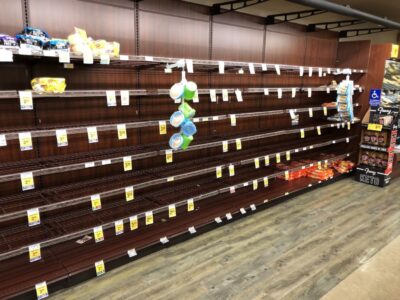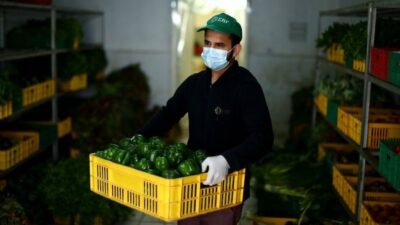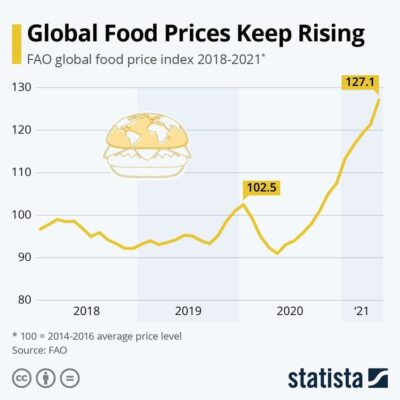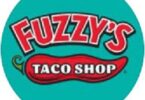The COVID-19 pandemic will soon reach another grim milestone: its two-year anniversary. If you had told me five years ago that we were going to be in a pandemic for two years, I would’ve probably shrugged you off and labeled you an anxious pessimist. After all, five years ago, summer ’16 took place – collectively considered to be the “last great summer.” Had you proceeded to tell me that this pandemic would completely upend society and revolutionize everything we considered “normal” in society, I might’ve actually laughed in your face. But here we are – almost two years since the first case of the virus was discovered in the United States. Nobody’s laughing now.
Vaccines were a pleasant breakthrough, but the emergence of new variants, like Delta and Omicron, tested, and will continue to test, humanity’s resilience in an unprecedented manner. Along with everyday people, businesses across multiple industries have also succumbed to the severe impacts of the pandemic. The food industry, for example, continues to be plagued by a global supply chain crisis.

Source: The Counter
What are global supply chains?
You may be wondering exactly what a food supply chain is. Essentially, it is the life cycle of food products, from production to consumption. The rise of globalization intertwined markets, and the food industry was not an exception. The food you eat today most likely has roots in other parts of the world. The scale of global supply chains within the industry is unfathomable. This intricate, delicate system accounts for 10% of the global GDP and employs over 1.5 billion people. As the system has developed and modernized, countries have become more reliant on one another to provide food that they cannot either physically grow or afford to grow. While this has diversified diets for the better, it has also made us more vulnerable to the consequences of fluctuations within the industry.
The impact of the pandemic on global supply chains
For one, the pandemic has disrupted the transport of food and the logistics behind producing that food. In response to growing concerns over the spread of the virus, governments implemented restrictions on travel. In addition to impeding the physical transportation of food, this also prevented labor migration, thus creating labor shortages. While worker-shortages were an issue even before the pandemic, the issue became exacerbated with worker-intensive agricultural practices, including animal cultivation and harvesting, facing significant downturn. It is important to acknowledge that most farmers are small-scale and thus, not well-connected with global supply chains. The scale of their production can only match a portion of the demand of local markets, not entire vicinities. This plays into the vulnerability of global supply chains.
Furthermore, the pandemic also widened the gap between consumer demand of food products and their supply by manufacturers. When increased standards were implemented in the meat industry, for example, production significantly declined and could not keep up with consumer demand. Similarly, in the case of supermarket groceries, demand significantly increased as consumers resorted to eating at home. Supply could not keep up with this massive surge in demand. Labor shortages and transportation logistics played a role, but an overarching reason for the disparity was a mismanagement of buyer-supplier relations. Those that supplied food to restaurants, schools, hotels, etc. did not have a buyer and thus, had wasted food products. Meanwhile, grocery stores did not have an adequate number of suppliers to keep up with shortages as demand continued to rise. Had steps been taken in advance, the situation might have played out differently.

Source: BBC
Moreover, the pandemic also significantly changed consumer behavior and demand for food products. Human food consumption is not an independent occurrence; the way we consume is multifactorial. One factor that influenced consumer demand was a change in personal finance for the average individual. There is no doubt that COVID created a financially precarious society. The pandemic left many out of work and heightened concerns about job security. Therefore, consumers did not want to spend exorbitant amounts of money on food; they wanted to stick within the constraints of their budget. At the same time, when combatting an infectious pathogen, people also wanted to eat natural, healthy food. Because many could not (and opted not to) purchase food from restaurants, they resorted to home-cooked meals. As such, demand for products with high shelf-lives (ie. Canned food, bread, etc.) and natural ingredients (ie. Fruits, vegetables, legumes, whole grains, etc.) substantially increased. In fact, the market for natural products boomed in the middle of March 2020, with a 78% increase in the amount purchased when compared to the year prior. The market for these products is still hot today. Overall, food prices in most categories inevitably rose because of the changing social and economic climate across the world.
The Road Ahead
So, what’s next?
That’s a loaded question.
If you poll all the expert analysts within the industry, you will find one common theme: nobody exactly knows what the hell the future will look like. Variants like Omicron take what we think we know about shifting patterns and supply chains and throw it out the window. The hope is that we can design innovative and resilient measures to counteract the inherent delicacy of these supply chains. There are a few logical arguments I will address, that may provide some glimpse on what we can expect moving forward.
Eventually, COVID restrictions will be lifted across the world. This should free up barriers of migration, and we are projected to see an economic boom across multiple sectors. This is not to say that the price of food will magically drop overnight, as economic concerns like inflation, are growing in countries such as the United States. Though, if proper recuperative measures are taken, the agricultural industry will be more acquainted with global supply chains and will work to create a more robust system. Measures that should be taken include making shipping more efficient, improved analysis by suppliers, and developing a more agile supply chain. Currently, roughly 14% of food is lost in supply chains. The system is wasteful and fragile. This food waste is also directly related to the lack of energy efficiency in the agriculture industry. In a period of 10 years from 2007-2016, 23% of total anthropogenic greenhouse gas emissions came from agriculture and other means of land usage. There is rampant deterioration of the natural environment along with depletion of natural resources that will only make humanity more prone to future unamendable disasters.

Source: World Economic Forum
Many also project a reversal in a fifty-year trend of Americans consistently spending less of their disposable income on eating at home. Working from home is becoming normalized and is forecast to remain a trend even when the pandemic is officially over. Prior to the pandemic, it was common for individuals to grab breakfast on the way to work, eat out for lunch with colleagues, and perhaps have complimentary work dinners from time to time. Eating out often throughout the week was not uncommon for many. As more work becomes virtual, there is less of a need to travel outside of special occasions. People have also become accustomed to eating at home and adjusted their budgets to coincide with this. Many Americans have come to the realization that their grocery expenses are more economically viable than eating every meal at a restaurant. Grocery stores will maintain their popularity, while the methods of purchasing those goods may change (more store visits as opposed to online ordering).
Nobody knows when the crisis will truly end; if someone tells you they do, they’re lying to you. Right now, there is a massive traffic jam in products ranging from food to fuel. The average consumer will have to adapt to these changes until a more adequate system is put in place. This may mean coping with shortages at stores and paying more (or not buying) for previous dietary staples and “exotic” food items alike. There will be more emphasis on buying local, and while that will help alleviate some food security concerns, it will leave many craving the affordability and variety of global supply chains.
The future of the food industry is uncertain. The pandemic has taken previous concerns and bumped them up to the highest gear. Only time will reveal how these current trends and projections will manifest in the future. We are five-years removed from summer ’16 and while I wish I could go back to those days of unbounded freedom; we can only move forward. As Bob Dylan famously said, “The times they are a-changing.” If humanity is to stand the test of time, we must adapt and innovate.






